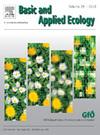Protected areas do not outperform urban wastelands in supporting insect pollinators and pollination in central Germany
IF 3.5
2区 环境科学与生态学
Q2 ECOLOGY
引用次数: 0
Abstract
The Natura 2000 network is central to Europe's conservation efforts to address biodiversity decline, with ongoing plans to expand protected areas and restore habitats across the European Union. However, due to the relative scarcity of biodiversity assessments within Natura 2000 sites, our understanding of how effective these areas are at protecting biodiversity and how they can be improved remains limited. At the same time, urban green spaces and associated disturbed, unmanaged vacant areas, also known as urban wastelands, have gained attention as potential conservation targets due to their high insect species richness. Here, we assess and compare the biodiversity of pollinators within Natura 2000 reserves and urban wastelands to evaluate their relative value for biodiversity protection and pollination services. To achieve this, we compared pollinator communities, their flower-visitation patterns and pollination services using potted experimental plants in flower-rich Natura 2000 sites and paired non-protected, unmanaged, yet similarly flower-rich urban wastelands. While the total biomass and overall abundance of insects did not differ between the two habitat types, wild bee abundance and richness were higher in urban wastelands, whereas pollinator communities were more heterogeneous among Natura 2000 sites. Though insect flower-visitation network metrics were similar across both habitats, seed set of experimental plants was higher in urban wastelands compared to Natura 2000 sites, indicating lower pollination services in the nature reserves. Our findings suggest that while Natura 2000 areas contained unique biodiversity compared to urban wastelands, the current status of protected areas in Germany is inadequate to conserve biodiversity hotspots for bees, including endangered species and the pollination services they provide. We highlight the potential for urban areas to support biodiversity conservation as well as the need to develop targeted strategies for bee conservation in Natura 2000 areas.
在德国中部,保护区在支持昆虫授粉和授粉方面的表现并不比城市荒地好
Natura 2000网络是欧洲应对生物多样性下降的保护努力的核心,它正在欧盟范围内扩大保护区和恢复栖息地的计划。然而,由于Natura 2000站点内的生物多样性评估相对稀缺,我们对这些区域在保护生物多样性方面的有效性以及如何改善它们的理解仍然有限。与此同时,城市绿地和相关的受干扰、未管理的空地,也称为城市荒地,由于其昆虫物种丰富度高,已成为潜在的保护目标。在此,我们评估和比较了Natura 2000保护区和城市荒地中传粉媒介的生物多样性,以评估其在生物多样性保护和授粉服务方面的相对价值。为了实现这一目标,我们在鲜花丰富的Natura 2000站点和配对的无保护、无管理但同样鲜花丰富的城市荒地上使用盆栽实验植物,比较了传粉昆虫群落、它们的访花模式和授粉服务。两种生境类型的昆虫总生物量和总丰度均无显著差异,但城市荒地的野生蜜蜂丰度和丰富度较高,而在Natura 2000生境类型中,传粉昆虫群落的异质性较大。尽管昆虫访花网络指标在两个栖息地相似,但与Natura 2000站点相比,城市荒地的实验植物种子集更高,表明自然保护区的授粉服务较低。我们的研究结果表明,尽管与城市荒地相比,Natura 2000地区具有独特的生物多样性,但德国保护区的现状不足以保护蜜蜂的生物多样性热点,包括濒危物种及其提供的授粉服务。我们强调了城市地区支持生物多样性保护的潜力,以及在Natura 2000地区制定有针对性的蜜蜂保护战略的必要性。
本文章由计算机程序翻译,如有差异,请以英文原文为准。
求助全文
约1分钟内获得全文
求助全文
来源期刊

Basic and Applied Ecology
环境科学-生态学
CiteScore
6.90
自引率
5.30%
发文量
103
审稿时长
10.6 weeks
期刊介绍:
Basic and Applied Ecology provides a forum in which significant advances and ideas can be rapidly communicated to a wide audience. Basic and Applied Ecology publishes original contributions, perspectives and reviews from all areas of basic and applied ecology. Ecologists from all countries are invited to publish ecological research of international interest in its pages. There is no bias with regard to taxon or geographical area.
 求助内容:
求助内容: 应助结果提醒方式:
应助结果提醒方式:


